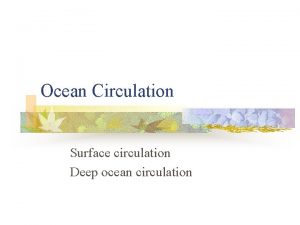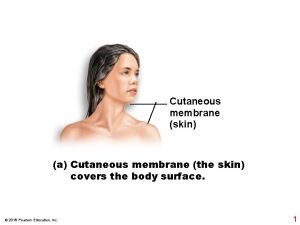Cutaneous circulation Dr Pushpa Lata Sachan Associate professor



















- Slides: 19

Cutaneous circulation Dr Pushpa Lata Sachan Associate professor C I M S & H , Lucknow

Cutaneous circulation • Functional anatomy –Blood supply of the skin of apical regions ( Fingers, feet , toes , palm, nose lip , ear lobes etc. ) is different from non apical regions (the body tarso) of the body. • Apical areas an arteriolar network exist at the boundary of dermis and subcutaneous tissue.



�From this network arterioles ascend from deep dermis to superficial layer of dermis. �Capillary loops originate from superficial dermal network and perfuse the dermal papilla and epidermis. �Non apical areas – here vascular pattern is modified. �Arteriovenous anastomoses mainly occur in superficial dermal tissue. �It Is very few or absent in non apical areas

�Normal blood flow to the skin varies from 1 to 150 ml per 100 g of tissue per min. �The skin blood vessel are supplied by sympathetic fibers. �No parasympathetic innervation is seen in the skin. �Activation of sympathetic fibers results in vasoconstriction. �Vasodilation occurs by decreasing the sympathetic activity.

Regulation of cutaneous blood flow �Is regulated by decreasing the sympathetic activity. �Cutaneous blood flow is regulated by neural , thermal and metabolic factors. �Neural regulation – cutaneous blood vessels are supplied by sympathetic vasoconstrictor fibers. �There is no vasodilator system supplying the skin blood vessels.

Thermal regulation �Thermal regulation – cutaneous blood flow is mainly regulated by body temperature. �Increased body temperature causes vasodilation and decreased body temperature causes vasoconstriction. �

HYPOTHALAMIC CONTROL MECHANISM Temperature Regulation centre of Hypothalamus

EXPOSURE

Metabolic regulation �Is not important for cutaneous circulaton. �Local production of bradykinin in the sweat causes cutaneous vasodilation.

Applied physiology �Vascular response to injury – �White response �Triple response � White response – Skin is stroked lightly with pointed object , stroke line become pale this is called as white reaction. �This occur due to decreased blood flow in the capillaries due to contraction of precapillary sphincter in response to injury. �The response is observed in about 15 second.

Triple response �When the skin is stroked with pointed object -the response to injury manifest as triple response. �This is called as triple response as it three component red , wheal and flare. �Red reaction – the skin becomes red in about 10 seconds. Redness occur due to capillary dilation that increases capillary blood flow. Capillary dilation occur due to direct response of capillaries to pressure.

�Wheal –swelling is called wheal. This occur within few minutes following red reaction. �It occur due to increased permeability of capillaries and post capillary venules. �Histamine released from local mast cells causes vasodilation and increases capillary permeability that result in extravasation of fluid.

�Flare - Spreading out of redness from the site of injury to surrounding area is called as flare. �It occur due to arteriolar dilation. � arteriolar dilation occur by activation of axon reflex. �From the site of injury impulse is conducted in the afferent fiber. �Sensory neuron give branches to blood vessel.

�The impulse in addition to its conduction to the spinal cord orthodomically, it also relayed antidromically to blood vessels �Axon reflex is an example of antidromic conduction of impulse. �The ending of sensory fibers on the blood vessels release substance P and CGRP that produce arteriolar dilation. �Redness spreads out from injury to surrounding skin in the form of flare.

Reactive hyperemia �This is defined as increased blood flow in an area when blood supply to the area is reestablished following a brief period of occlusion. �The blood flow to the skin increase when the circulation is reestablish after the short period of occlusion.

�Reactive hyperemia also occur in visceral organs. �It occur due to vasodilation produced by hypoxia during occlusion. �When circulation reestablished blood flow increases through dilated blood vessels and skin becomes red

 Promotion from associate professor to professor
Promotion from associate professor to professor Sachan thapa
Sachan thapa Triple response and cutaneous circulation
Triple response and cutaneous circulation Thin
Thin Single vs double circulatory system
Single vs double circulatory system Single circulation and double circulation
Single circulation and double circulation Zinc deficiency rash
Zinc deficiency rash Pushpa raj sharma
Pushpa raj sharma Dr pushpa raj sharma
Dr pushpa raj sharma Pushpa raj sharma
Pushpa raj sharma Pushpa raj sharma
Pushpa raj sharma Pushpa x ray
Pushpa x ray Dr pushpa raj sharma
Dr pushpa raj sharma Shukrashmari
Shukrashmari Dr pushpa raj sharma clinic
Dr pushpa raj sharma clinic Dr pushpa gross
Dr pushpa gross Dr pushpa raj sharma
Dr pushpa raj sharma Pushpa thapa
Pushpa thapa Dr pushpa gross
Dr pushpa gross Pushpa wood name
Pushpa wood name




































